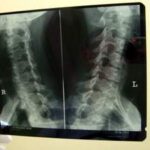Controlling muscle activities throughout the body is one of the functions of the human nervous system. When parts of the spinal cord and the brain (the two major organs of the nervous system) concerned with muscle activity become diseased, the action of the muscles correspondingly become radically different. This same result occurs when nerve connections between the muscles and the central nervous system are affected. In either case, the type of muscle activity alteration will provide a clue to the nature of the disorder.
Symptoms produced by nervous disorders include abnormalities of movement. The five most common abnormalities of movement associated with nervous disorders are gait disturbance, involuntary movements, muscular hypertonicity, paralysis, and tetany. Let us discuss these abnormalities of movement one by one here.
Gait disturbance is also referred to as walking difficulty. Many types of disturbance of the nervous system may cause interference to the normal progress of walking; this is so since walking is such a complex function. Such disturbances that may alter gait include spasticity or stiffness, weakness, and paralysis.
Involuntary, or uncontrollable, movements involving muscles or groups of muscles may develop in certain nervous disorders. Athetosis (slow, sinuous, writhing movements, usually of the hands and feet) and chorea (quick, jerky movements, usually of the head and limbs) are two examples of nervous disorders in which spontaneous, purposeless movements develop.
Muscular hypertonicity – also called spasticity – is another one of those abnormalities of movement that is linked to certain nervous disorders. Certain fundamental processes in the body cause the larger muscles to stay firm. This is clearly proven by the ability of an individual to maintain his posture without his giving continuous thought to his body movements. Once the individual uses these same muscles in some rapid movement, the very process or mechanism which causes them to remain firm is automatically offset, enabling the muscles to move quickly. In certain nervous disorders, this ability to release the muscles is lost so that these muscles stay firm even when the individual desires to move them quickly.
Paralysis refers to the absolute (not merely reduced) inability of a muscle or a group of muscles to respond to voluntary commands. Its usual cause is damage to the nerve or nerve tract which normally controls the muscles. The damage deprives the nerve or nerve tract of its ability to convey or transmit nerve impulses.
Tetany is a condition characterized by tonic spasm of muscles. In this condition, the muscles become abnormally responsive to stimulation. Tetany occurs in three conditions: tetanus (an acute infectious disease marked by tonic spasm of voluntary muscles, especially of the jaw), alkalosis (an abnormal condition of increased alkalinity of the blood and tissues), and hypoparathyroidism (deficiency of parathyroid hormone in the body, as when the serum calcium drops to low levels). But tetany can also occur in certain nervous disorders in which brain cells become abnormally responsive to ordinary stimuli.
It is a fact that any of these five abnormalities of movement causes general weakness, although weakness in itself may be considered a symptom of nervous disorders. In weakness associated with nervous disorders, there is the reduced ability to use muscles in the normal way; the causes may be some diseases of the nervous system which destroy the nerve centers controlling the actions of the muscles or of the nerve fibers which lead to these muscles.
As in all types of nervous disorders, treatment of any of these five abnormalities of movement must be closely supervised and monitored by a physician.
Sources:
1. “Movement Disorders” from Mayo Clinic – http://www.mayoclinic.org/movement-disorders/types.html
2. “Movement Disorders” from the Neurology Channel – http://www.neurologychannel.com/movementdisorders/index.shtml






